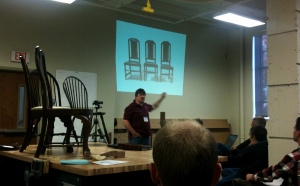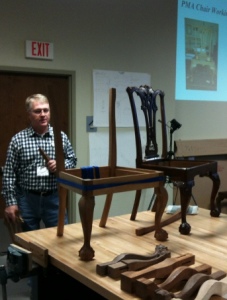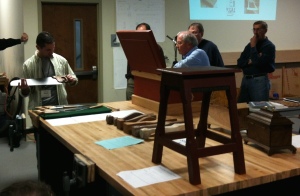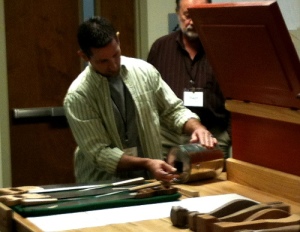SAPFM Chesapeake Chapter Meeting
This past Saturday I headed up to Harrisburg, PA for a meeting of the Chesapeake Chapter of the Society of American Period Furniture Makers. It was located in the local community college wood shop which was a great space to meet. I was a bit dismayed however to find the woodshop full of nothing but power tools. I can only hope that there is a bench room somewhere else in the building as I hope that fundamental hand skills haven’t just been dropped from the curriculum. Of course I guess I should just be happy there is a woodshop at all considering the state of shop in schools today.
 The Chesapeake Chapter of SAPFM is the newest chapter and this was only our second meeting. So far the chapter is off to a rip roaring start. This time we had Chuck Bender on hand to give a slightly more involved version of his WIA presentation: Furniture Design, the Good, the Bad, and the Ugly. Speaking to a room of 18th century furniture geeks definitely appealed to Chuck since this is his where his experience lies and we had a great discussion about design that doesn’t rely upon mathematical proportions and dividers and such. Chuck emphasized that it is about training your eye to find what looks good and what doesn’t. What was interesting to me was how examining an individual piece in detail yielded one reaction and then putting it up against a similar piece changed that reaction. There were several chests that I really liked until they were compared side by side with another. Suddenly the height of the foot or graduation of the drawers looked off in the first piece and it changed my entire feeling for the first chest. From that moment on, I began to examine each furniture piece in greater detail and more quickly was able to identify what worked and what didn’t. It is a good exercise that bears repeating as I often find myself looking through museum books and assessing a piece individually because of the way these books are normally laid out. I urge you to try this and see for yourself what a difference it makes to your perception of a piece. In today’s digital world it should not be too hard to paste a couple of images onto the same page.
The Chesapeake Chapter of SAPFM is the newest chapter and this was only our second meeting. So far the chapter is off to a rip roaring start. This time we had Chuck Bender on hand to give a slightly more involved version of his WIA presentation: Furniture Design, the Good, the Bad, and the Ugly. Speaking to a room of 18th century furniture geeks definitely appealed to Chuck since this is his where his experience lies and we had a great discussion about design that doesn’t rely upon mathematical proportions and dividers and such. Chuck emphasized that it is about training your eye to find what looks good and what doesn’t. What was interesting to me was how examining an individual piece in detail yielded one reaction and then putting it up against a similar piece changed that reaction. There were several chests that I really liked until they were compared side by side with another. Suddenly the height of the foot or graduation of the drawers looked off in the first piece and it changed my entire feeling for the first chest. From that moment on, I began to examine each furniture piece in greater detail and more quickly was able to identify what worked and what didn’t. It is a good exercise that bears repeating as I often find myself looking through museum books and assessing a piece individually because of the way these books are normally laid out. I urge you to try this and see for yourself what a difference it makes to your perception of a piece. In today’s digital world it should not be too hard to paste a couple of images onto the same page.
 At the same time, Chuck and several other members brought in actual furniture pieces and this brought up the even greater experience that comes from examining a piece in real life. We are blessed in the mid atlantic to be so close to so many great museums full of period furniture and getting some “face” time with Philadelphia chairs and Windsors reminded me that I need to make a better effort to get out to these museums more often. Pictures in books are great, but you lose a sense of the scale and visceral reaction that is evoked by standing in front of the piece and seeing how the light strikes it from different angles.
At the same time, Chuck and several other members brought in actual furniture pieces and this brought up the even greater experience that comes from examining a piece in real life. We are blessed in the mid atlantic to be so close to so many great museums full of period furniture and getting some “face” time with Philadelphia chairs and Windsors reminded me that I need to make a better effort to get out to these museums more often. Pictures in books are great, but you lose a sense of the scale and visceral reaction that is evoked by standing in front of the piece and seeing how the light strikes it from different angles.
This was a great meeting and we have a lot of talent and experience in this chapter. The member show and tell was the perfect example of the knowledge to be tapped. Several members brought in Philadelphia side chairs in progress as part of a working group build and we got to hear about what they were learning and how they were tackling this very difficult piece.
 I was happy to see fellow blogger Jamie Bacon of the Plane Shavings blog there to show off his tool chest, chisels, and saws. Jamie was being overly humble, but it was still exciting to see what someone with no metalworking tools and some patience can produce. His tools were beautiful and his paint can forge was innovative. If you haven’t yet, check out Jaime’s blog there is a lot of great stuff there.
I was happy to see fellow blogger Jamie Bacon of the Plane Shavings blog there to show off his tool chest, chisels, and saws. Jamie was being overly humble, but it was still exciting to see what someone with no metalworking tools and some patience can produce. His tools were beautiful and his paint can forge was innovative. If you haven’t yet, check out Jaime’s blog there is a lot of great stuff there.
 Our next meeting is in the Spring and we will have Don Williams as our keynote speaker talking about finishing. It will be held in my backyard at J. Gibson McIlvain lumberyard where I work. This meeting will be April 21st, 2012 and should be a great event.
Our next meeting is in the Spring and we will have Don Williams as our keynote speaker talking about finishing. It will be held in my backyard at J. Gibson McIlvain lumberyard where I work. This meeting will be April 21st, 2012 and should be a great event.


